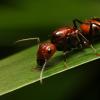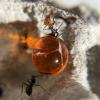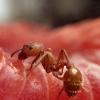Pogonomyrmex occidentalis
Abstract
Pogonomyrmex occidentalis, commonly referred to as the 'Western Harvester Ant,' is one of the hardiest and successful species of western North America. It inhabits arid landscapes from the frigid prairies of Canada's prairie provinces and the Dakotas all the way down to the scorching deserts of Arizona, California, and northern Mexico. Workers are 6.5-10 mm in length, and queens are generally 11-14 mm. Their large size, powerful mandibles for digging, and hardiness helped make them the staple of your 'Uncle Milton Ant Farms' from Amazon and such, making them some of the most well-known ants to ant keepers and non-ant keepers alike.
It is currently the only species to be deregulated by the USDA for interstate transport in the contiguous U.S., making them a top seller in the ant keeping market.
As with the rest of the genus Pogonomyrmex as well as Veromessor and Novomessor also from North America and Messor from Eurasia and Africa, their common name 'Harvester Ant' is indicative of their seed-based diet, which they collect off of the desert/prairie floor. Since the sugar-rich substances most common ant species rely on for survival is scarce in such arid environments, they must rely on seeds and occasional dead insects to survive. In order to collect seeds, many species of Pogonomyrmex including occidentalis developed a cradle of hairs below their mandibles which acts as a 'basket' for them to carry seeds in. Favorite seed varieties for this species include dandelion, bluegrass, wheatgrass, chia, and flax.
Wild colonies construct dome-shaped nests which trap heat from the sun, helping to incubate their brood for faster development rates. These nests can extend multiple meters/yards down, as this species, despite being endemic to arid landscapes, is moisture loving and needs to dig deep in order to tap into ground moisture. They predominantly nest in open clearings, and actively clear away brush and debris from their nests, making them quite conspicuous.
In captivity this species is quite hardy, growing quickly to hundreds of workers in their first year if properly heated and fed, and grow to over 20,000 in the wild. This species, being from generally hot, arid climates, requires high temperatures to thrive. High 80s to low 90s Fahrenheit is paradise for them. Anything much lower than that will cripple their development and cause them to grow at a snail's pace. While they can hibernate, they do not need to and will stay active all year round if given heat. If hibernated by choice, they should be kept in the 50s, which is hellishly cold for these heat-loving ants. These ants do sting. While painful, it is comparable to only a mild bee sting. Yellowjackets and all sorts of wasps are far worse pain-wise, so as long as you don't do anything stupid the stinging part is not an issue. This is further enforced by the fact that these ants struggle to climb smooth surfaces including glass and plastic. Due to this they do not require an escape barrier in their outworld to keep them contained. They are active, large, hardy, and overall fun to keep, making them the perfect species for the casual and dedicated ant enthusiast alike.
Resources
Journals:
Articles:
Pogonomyrmex occidentalis - AntWiki
Pogonomyrmex occidentalis (navajonature.org)
Tar Heel Ants Pogonomyrmex occidentalis Guide
Pogonomyrmex occidentalis (Grassland Harvester Ants) Care Guide: – The Ant Vault
Entomological Society of America | Oxford Academic (oup.com)
Recruiting ants to fight weeds on the farm | ScienceDaily
Update 1
October 6, 2024
Introduction
I've had a long, interesting history with this species. I began my journey in February of 2020, in the thick of the COVID-19 pandemic. This was soon after the species became the first and only to be deregulated by the USDA for interstate transport, i.e. a PPQ526 permit is not require to bring these ants over state boarders. I bought two queens from Utah Ants, which started out great, though due to my inexperience with the species I placed them in a plain test tube with crappy substrate, and they did not do well, and eventually died of a fungal infection that was plaguing my other colonies.
Soon after in early March I picked up a colony from TarHeelAnts, which became my success colony. It came with around 30 workers, and I moved them into a THA Palladium, which they loved. They grew to over 300 workers in 8 months until I moved them into a test homemade formicarium which ended up killing them. Shortly after I ordered another colony from THA which had around 5 workers. Soon after they arrived, my Tetramorium colony (not my current ones) which had about 1,500 workers at the time broke out of their THA Fortress and murdered that colony. I decided to stop spending so much money on Pogonomyrmex (THA jacks up their prices on them like a car dealership) and forgot about them until recently.
After reading AntsTx's new journal, I reminisced about the good old days, when I had a thriving colony that wasn't being genocided on by Tetras or dying of strange fungal infections, and decided I want to try again. This species lives in the western portion of South Dakota, though considering I live in the far eastern extreme of the state, I did not fancy driving 5 hours on the chance I might catch a flight. It's much easier to buy. So, I surveyed the current market, finding that StateSide Ants and Buckeye Myrmecology sold them at a 'discount price' (by THA standards, anyways) at around $35-$40 USD compared to THA's $60-$100 depending on colony size. I then remembered that UtahAnts sells queens in bulk, and I saw in one of his posts on using dirt containers to found queens in a picture of dozens of healthy-looking P. occidentalis queens, which prompted me to DM him inquiring about available stock and pricing. Since he ships in bulk, I was able to get a crazy good deal, as in the cheapest you could ever expect to find an ant colony. I took the opportunity to buy 2, because why not. I asked Ants_Dakota if he wanted in to consolidate shipping, and he also ordered 2 colonies which he will be using for a research paper he will publish in the future. I will link it and his journal once they are finished. The extra 2 colonies in the order brought the price per unit even lower, making me question why I paid $80 for a single common ant colony.

By UtahAnts. My queens are probably in there somewhere.
Colony A
The colonies arrived yesterday, Saturday, Oct. 6 in small dirt containers. 2 of them had over 10 workers and the other two had around 5. I'm keeping one the good ones (Colony A) and giving the other to Ants_Dakota, and we will each have a less successful colony as well.
Colony A is starting out strong, with 16 workers. They only came with a couple brood items, though I suspect now that I fed them the queen will resume egg laying within the next few days. I moved them out of the dirt setup into a test tube with a Por Amor test tube insert, and they settled in perfectly. They were sluggish at first, as it's starting to cool off around here (the high today was 67, frigid for Pogonomyrmex). They perked back up immediately after being put on heat. Ants_Dakota and I plan to have an outworld-making heyday next Saturday, but until then I kicked the queenless remnants of Tetramorium immigrans Colony E out of their pencil-case outworld to make room for the new top dogs (and also to take revenge for the massacre committed by their ancestors). One Tetra worker got left behind, and it is being hunted as we speak in classic Tom & Jerry style. I scattered some grass seed mix into their outworld, and they immediately sent multiple workers out to collect the paycheck. Meanwhile back inside the nest, the queen and other workers were busy tearing open the seeds and having a feast. The future looks bright for this colony, and I'm so grateful I won't have to spend the winter alone with three ravenous Tetra colonies (I won't be hibernating them). Oh, and also, if one of my Tetra colonies escapes and murders this colony like last time, I swear on everything Myrmecological I will Yeet. That. Colony. OUT. MY. WINDOW!!! Anyways, moving on...
This was before I put them on heat, please excuse their sluggishness. I wish ants were that calm for photo shoots all the time.
Colony B
This colony was stunted developmentally compared to Colony A, with only 4 workers currently (3 died in transit) and 6 large larvae and pupae. I also moved them into a test tube with a Por Amor insert, which they also love. Seeing as they only have 4 workers, they are much more timid foragers and have yet to take advantage of the blessed seed rain which was bestowed upon them earlier today. They still look healthy and will do fine, they just won't grow quite as fast as Colony A. They're like Tetramorium immigrans Colony C (may they rest in pieces) if you've read that journal. If Colony A really takes off, I may eventually sell them or give them to a friend, we'll see.
This was also before I put them on heat.
Thanks again to UtahAnts for these amazing colonies! He is leaving us for a mission's trip in a couple weeks, so I wanted to give him my best and thank him for all his contributions to the community. We look forward to having you back in 2027. Good luck, and God bless!
Edited by RushmoreAnts, March 7 2025 - 6:50 PM.






















